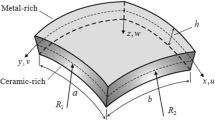Abstract
We perform finite element analysis of the so called Girkmann problem in structural mechanics. The problem involves an axially symmetric spherical shell stiffened with a foot ring and is approached (1) by using the axisymmetric formulation of linear elasticity theory and (2) by using a dimensionally reduced shell-ring model. In the first approach the problem is solved with a fully automatic hp-adaptive finite element solver whereas the classical h-version of the finite element method is used in the second approach. We study the convergence behaviour of the different numerical models and show that accurate stress resultants can be obtained with both models by using effective post-processing formulas.







Similar content being viewed by others
References
Ainsworth M, Oden J (2000) A posteriori error estimation in finite element analysis. Wiley, New York
Andersson B, Falk U (1987) Self-adaptive analysis of three-dimensional structures using a p-version of finite element method. Report FFA TN 1987-31, The Aeronautical Research Institute of Sweden
Andersson B, Falk U, Babuška I, von Petersdorff T (1995) Reliable stress and fracture mechanics analysis of complex components using a h − p version of FEM. Int J Numer Methods Eng 38:2135–2163
Babuška I, Miller A (1984) The post-processing approach in the finite element method—part 1: calculation of displacements, stresses and other higher derivatives of the displacements. Int J Numer Methods Eng 20:1085–1109
Babuška I, Strouboulis T (2001) The finite element method and its reliability. Oxford University Press, Oxford
Babuška I, Whiteman J, Strouboulis T (2011) Finite elements: an introduction to the method and error estimation. Oxford University Press, Oxford
Chapelle D, Bathe KJ (2000) The mathematical shell model underlying general shell elements. Int J Numer Methods Eng 48:289–313
Demkowicz LF (2007) Computing with hp-Adaptive finite elements. One and two dimensional elliptic and Maxwell problems, vol 1. CRC Press, New York
Dvorkin EN, Bathe KJ (1984) A continuum mechanics based four-node shell element for general non-linear analysis. Eng Comput 1:77–88
Girkmann K (1954) Flächentragwerke. Springer, Wien
Guide for Verification and Validation in Computational Solid Mechanics (2006) ASME V&V 10-2006. The American Society of Mechanical Engineers, New York
MacNeal RH (1978) A simple quadrilateral shell element. Comput Struct 8:175–183
Malinen M (2002) On the classical shell model underlying bilinear degenerated shell finite elements: general shell geometry. Int J Numer Methods Eng 55:629–652
Niemi AH (2008) Approximation of shell layers using bilinear elements on anisotropically refined rectangular meshes. Comput Methods Appl Mech Eng 197:3964–3975
Niemi AH (2010) A bilinear shell element based on a refined shallow shell model. Int J Numer Methods Eng 81:485–512
Oberkampf WL, Roy CJ (2010) Verification and validation in scientific computing. Cambridge University Press, London
Pitkäranta J, Babuška I (2011) The dome and the ring: verification of classical back-of-the-envelope models for designing a stiffened shell roof. (to appear)
Pitkäranta J, Babuška I, Szabó BA (2008) The Girkmann problem. IACM Expr 22:28
Pitkäranta J, Leino Y, Ovaskainen O, Piila J (1995) Shell deformation states and the finite element method: a benchmark study of cylindrical shells. Comput Methods Appl Mech Eng 128:81–121
Pitkäranta J, Matache AM, Schwab C (2001) Fourier mode analysis of layers in shallow shell deformations. Comput Methods Appl Mech Eng 190:2943–2975
Pitkäranta J, Szabó BA, Babuška I (2009) The problem of verification with reference to the Girkmann problem. IACM Expr 24:14–15
Roache PJ (2009) Fundamentals of verification and validation. Hermosa, New Mexico
Szabó BA, Babuška I, Pitkäranta J, Nervi S (2010) The problem of verification with reference to the Girkmann problem. Eng Comput 26:171–183
Tews R, Rachowicz W (2009) Application of an automatic hp adaptive finite element method for thin-walled structures. Comput Methods Appl Mech Eng 198:1967–1984
Xue L, Demkowicz L (2002) Geometrical modeling package, version 2.0. Technical report 30, TICAM
Zienkiewicz OC, Taylor RL, Too JM (1971) Reduced integration technique in general analysis of plates and shells. Int J Numer Methods Eng 3:275–290
Author information
Authors and Affiliations
Corresponding author
Appendix: Summary of challenge problem results
Appendix: Summary of challenge problem results
We reproduce here from [23] the results received in response to the Girkmann challenge problem. The four results based on the p-version and the eleven results based on the h-version are shown in Tables 5 and 6, respectively.
Rights and permissions
About this article
Cite this article
Niemi, A.H., Babuška, I., Pitkäranta, J. et al. Finite element analysis of the Girkmann problem using the modern hp-version and the classical h-version. Engineering with Computers 28, 123–134 (2012). https://doi.org/10.1007/s00366-011-0223-0
Received:
Accepted:
Published:
Issue Date:
DOI: https://doi.org/10.1007/s00366-011-0223-0




